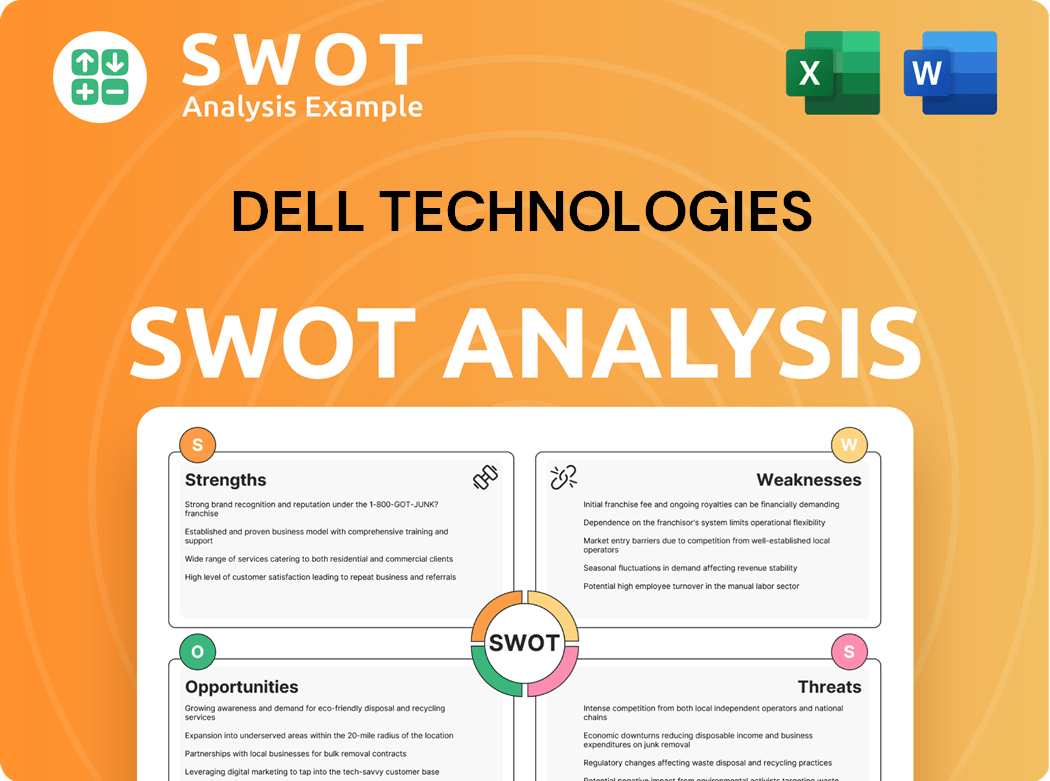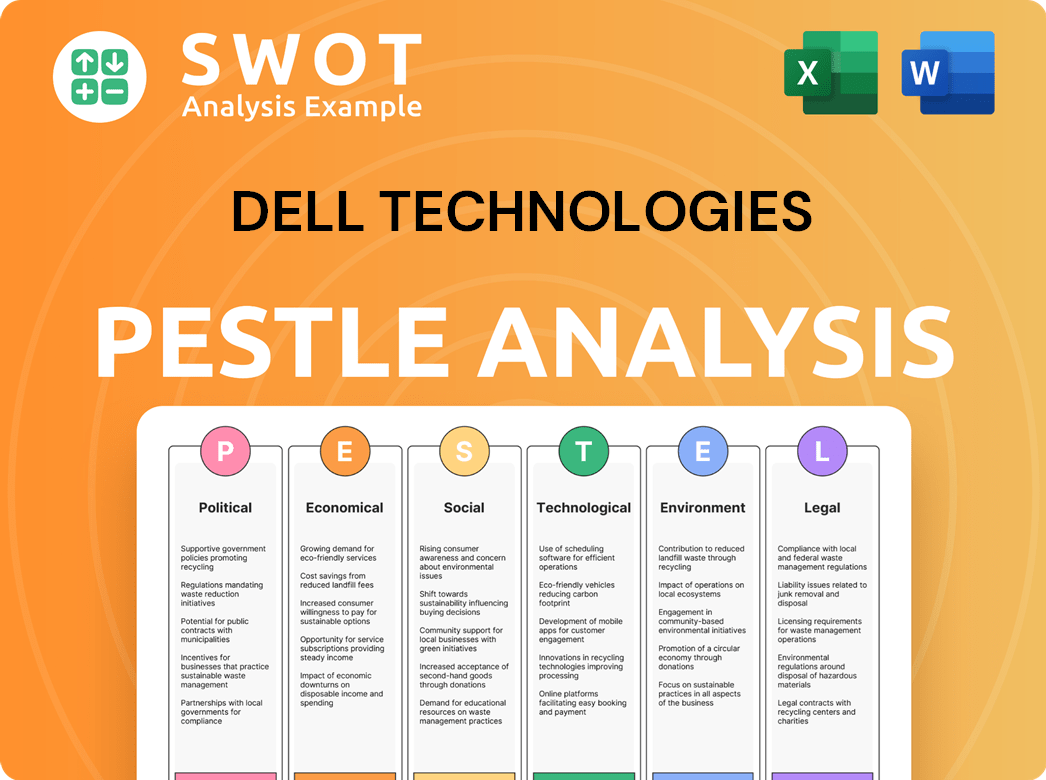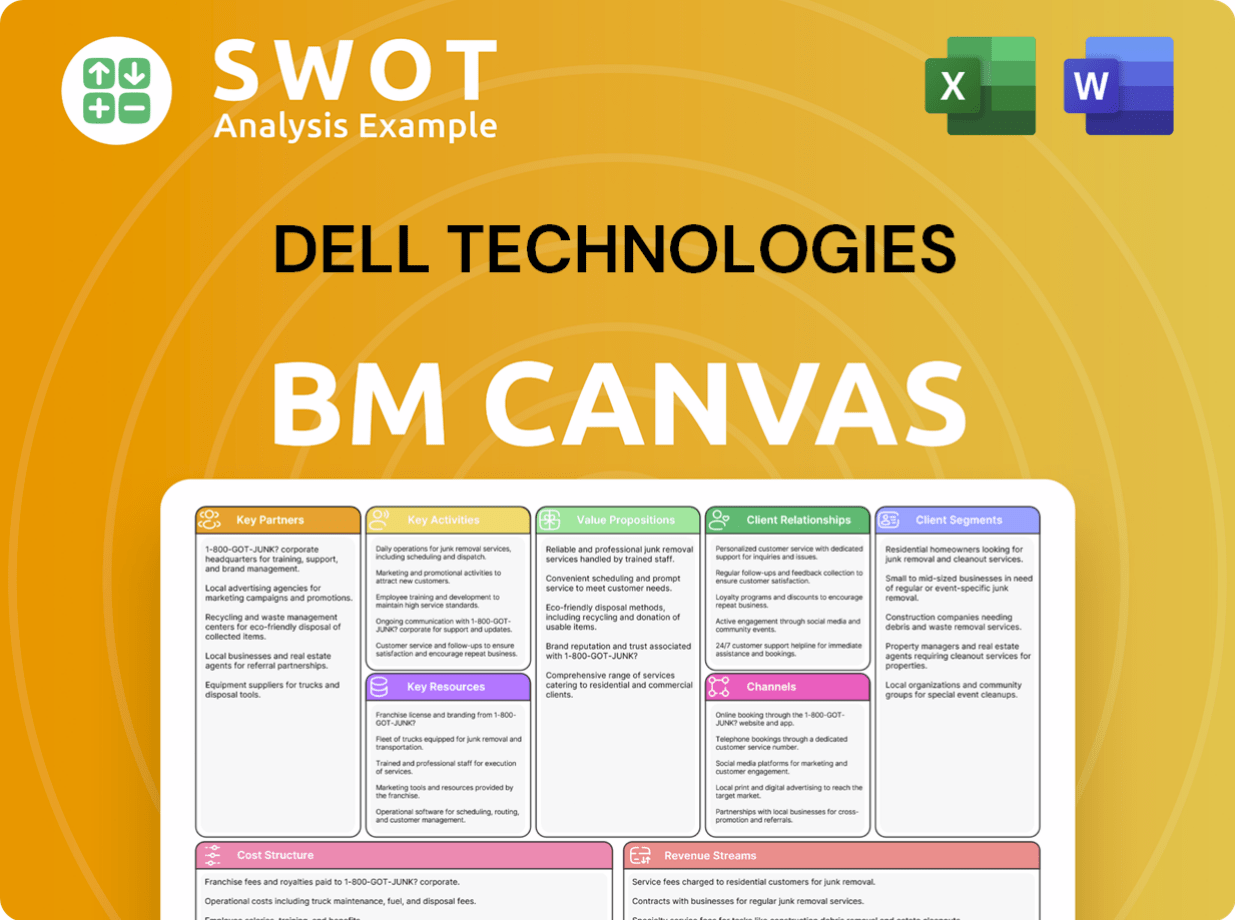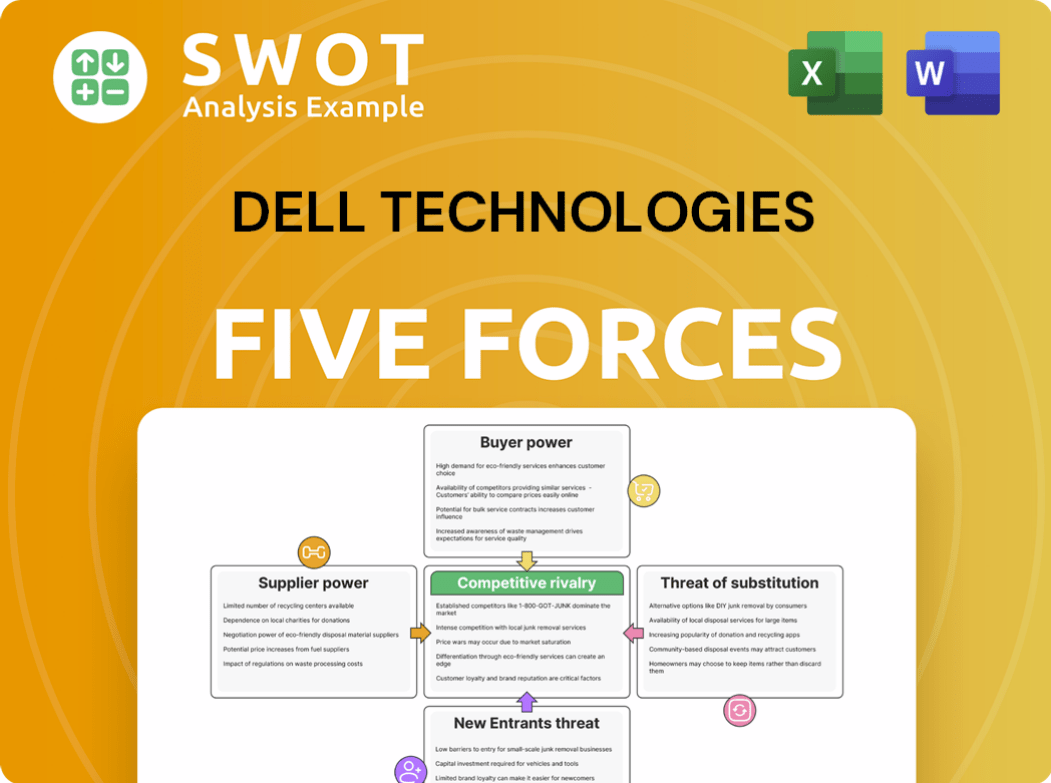Dell Technologies Bundle
Can Dell Technologies Maintain Its Edge in the Tech Arena?
From its disruptive direct-to-consumer model to its current status as an IT behemoth, Dell Technologies has consistently redefined the tech landscape. But in a world of relentless innovation and fierce competition, how does Dell stack up against its rivals? This analysis dives deep into the Dell Technologies SWOT Analysis, examining its competitive positioning and strategic moves.

This exploration of the Dell Technologies competitive landscape will dissect its key rivals, evaluate its market share, and provide a thorough Dell industry analysis. We'll examine Dell's business strategy, including its product portfolio, and assess its competitive advantages in the dynamic tech sector. Furthermore, we'll compare Dell Technologies vs HP and Dell Technologies vs Lenovo to understand their market position analysis, and delve into the future outlook and competition facing Dell Technologies.
Where Does Dell Technologies’ Stand in the Current Market?
Dell Technologies holds a significant market position, driven by its Client Solutions Group (CSG) and Infrastructure Solutions Group (ISG). In Q1 2024, Dell shipped 9.8 million units, securing 16.7% of the global PC market share, placing it among the top three vendors. This strong performance in PCs is complemented by its robust presence in the server market.
Dell's core operations revolve around providing a comprehensive suite of IT solutions. Its primary product lines include desktops, notebooks, workstations, servers, storage, and networking solutions. Dell serves customers across various segments, from individual consumers and small businesses to large corporations and government agencies. The company has strategically shifted its positioning, evolving beyond hardware to become a comprehensive IT solutions provider.
Dell's value proposition centers on delivering end-to-end IT solutions that drive digital transformation. This includes hardware, software, and services designed to meet the diverse needs of its global customer base. The acquisition of EMC was a pivotal move, significantly expanding its offerings in storage, data protection, and cybersecurity, enhancing its competitive edge. For a deeper dive into their marketing approach, consider exploring the Marketing Strategy of Dell Technologies.
Dell Technologies maintains a strong market position across multiple IT sectors. In the PC market, Dell ranks among the top vendors. Dell has a significant presence in the server market, often leading in market share. The company's strategic moves and acquisitions have solidified its competitive standing.
Dell offers a broad range of products, including desktops, notebooks, servers, and storage solutions. The company provides comprehensive IT solutions, including hardware, software, and services. Dell's focus on digital transformation and cloud-based services enhances its value proposition.
Dell reported a revenue of $22.2 billion for Q1 fiscal year 2025. The company's operating income for the same period was $1.5 billion. Dell's financial performance reflects its strong position in the IT market.
Dell is strengthening its position in high-growth areas like AI servers. The company saw a 42% sequential increase in AI server orders in Q1 fiscal year 2025. This focus on emerging technologies helps Dell stay competitive.
Dell's competitive landscape is shaped by its strong market share in PCs and servers. The company's focus on comprehensive IT solutions and strategic acquisitions, such as EMC, has expanded its capabilities. Dell's financial performance and strategic investments in areas like AI servers highlight its adaptability and growth potential.
- Dell Technologies competitive landscape is influenced by its product portfolio and market presence.
- Dell competitors include major players in the IT industry, such as HP and Lenovo.
- Dell market share in PCs and servers demonstrates its strong position.
- The company's strategic focus on emerging technologies like AI servers is a key driver.
Dell Technologies SWOT Analysis
- Complete SWOT Breakdown
- Fully Customizable
- Editable in Excel & Word
- Professional Formatting
- Investor-Ready Format

Who Are the Main Competitors Challenging Dell Technologies?
The Owners & Shareholders of Dell Technologies face a dynamic competitive landscape. The company's success depends on its ability to navigate this environment effectively. Understanding the key rivals and their strategies is crucial for assessing Dell's market position and future prospects.
Dell Technologies operates in a highly competitive market, with rivals vying for market share across various product categories. This competition influences pricing, innovation, and distribution strategies. The company's ability to differentiate itself and maintain a competitive edge is essential for sustained growth.
Dell Technologies' competitive landscape is multifaceted, encompassing both direct and indirect competitors. The company's diverse product and service portfolio faces challenges from various players. Understanding these competitive dynamics is crucial for evaluating Dell's market position and strategic initiatives.
In the Client Solutions Group (CSG), Dell faces strong competition. Key rivals include HP Inc., Lenovo, and Apple. These companies compete fiercely in the PC market, driving innovation and price competitiveness.
HP Inc. is a major competitor in the PC market. In Q1 2024, HP Inc. held a 20.1% share of the global PC market. They compete aggressively on price and features.
Lenovo is another significant player in the PC market. Lenovo led the global PC market with a 23% share in Q1 2024. Their extensive distribution network is a key strength.
Apple competes in the premium segment of the PC market. They have a smaller overall market share but appeal to a distinct customer base. Apple's integrated hardware and software ecosystem is a key differentiator.
In the Infrastructure Solutions Group (ISG), Dell faces competition from various companies. Key rivals include Hewlett Packard Enterprise (HPE), Cisco, IBM, and cloud service providers. The rise of cloud computing adds another layer of competition.
HPE is a direct competitor in servers, storage, and networking. They often compete head-to-head for enterprise contracts. HPE's focus on hybrid cloud solutions is a key strategy.
Cisco is a major player in networking hardware and software. They provide comprehensive networking solutions for enterprises. Cisco's market position is strong in the networking sector.
IBM competes in enterprise hardware, software, and services. They offer a wide range of solutions for businesses. IBM's focus on hybrid cloud and AI is notable.
Cloud service providers like AWS, Microsoft Azure, and Google Cloud challenge Dell's on-premises infrastructure business. These companies are driving the shift to cloud computing. Dell is responding with hybrid cloud solutions.
The competitive landscape for Dell Technologies is constantly evolving. Emerging players and technological advancements pose ongoing challenges. Understanding these threats is crucial for strategic planning and maintaining market share.
- AI Hardware and Cybersecurity: Emerging players in specialized areas like AI hardware and cybersecurity also pose a threat.
- Cloud Computing: The increasing adoption of cloud computing continues to reshape the IT landscape.
- Market Fragmentation: The industry is becoming more fragmented, with new entrants and specialized solutions.
- Hybrid Cloud Solutions: Dell is developing hybrid cloud solutions to remain competitive in the face of cloud adoption.
Dell Technologies PESTLE Analysis
- Covers All 6 PESTLE Categories
- No Research Needed – Save Hours of Work
- Built by Experts, Trusted by Consultants
- Instant Download, Ready to Use
- 100% Editable, Fully Customizable

What Gives Dell Technologies a Competitive Edge Over Its Rivals?
Analyzing the Target Market of Dell Technologies reveals a company built on several key competitive advantages. These advantages have allowed it to maintain a strong position within the dynamic tech industry. The company's strategic moves and focus on innovation are critical to understanding its competitive edge.
One of the most significant strengths is its comprehensive product portfolio. Dell offers a wide range of products, from client devices to enterprise infrastructure. This breadth allows it to serve as a one-stop shop for many customers, simplifying their IT needs. This is a key aspect of the company's business strategy.
Dell's direct sales model, though evolving, has historically fostered strong customer relationships. This approach allows for greater customization and efficiency. The company's investments in R&D, particularly in high-growth areas like AI and multi-cloud solutions, further strengthen its market position.
Dell's ability to provide comprehensive solutions, from client devices to enterprise infrastructure, simplifies procurement and management for customers. This is a significant differentiator in the Dell Technologies competitive landscape. The integration of hardware, software, and services allows for a streamlined IT experience.
The direct sales model, historically used by Dell, has fostered strong customer relationships and allowed for greater customization. This approach builds customer loyalty, particularly among large enterprises. This model has been a key component of Dell's success.
Dell has cultivated a strong brand reputation for reliability, service, and support over decades. This has resulted in a loyal customer base. This brand equity is a valuable asset in the competitive market.
Dell's global supply chain and operational efficiencies contribute to economies of scale and cost advantages. These efficiencies are crucial for maintaining profitability in a competitive market. This operational excellence supports its market share.
Dell's competitive advantages include its broad product portfolio, direct sales model, brand equity, and operational efficiencies. These factors contribute to its strong market position. The company's continuous investment in R&D, particularly in AI and multi-cloud solutions, ensures it remains competitive.
- Product Portfolio: Dell offers a wide range of products, from client devices to enterprise infrastructure.
- Customer Relationships: The direct sales model fosters strong customer relationships.
- Brand Equity: Dell has a strong reputation for reliability and service.
- Operational Efficiencies: A global supply chain provides economies of scale.
Dell Technologies Business Model Canvas
- Complete 9-Block Business Model Canvas
- Effortlessly Communicate Your Business Strategy
- Investor-Ready BMC Format
- 100% Editable and Customizable
- Clear and Structured Layout

What Industry Trends Are Reshaping Dell Technologies’s Competitive Landscape?
Understanding the current and future landscape for companies like Dell Technologies requires a close look at industry trends, potential challenges, and emerging opportunities. The IT sector is dynamic, with shifts in technology and market demands reshaping how companies compete and grow. Analyzing these factors is crucial for investors, strategists, and anyone interested in the future of technology.
The competitive landscape for Dell Technologies is influenced by various factors, including technological advancements, economic conditions, and the strategies of its competitors. Assessing these elements helps in understanding Dell's market position, potential risks, and future outlook, providing a comprehensive view of its competitive dynamics. A detailed examination aids in making informed decisions about the company's prospects.
The IT industry is experiencing rapid changes, with several key trends shaping the competitive landscape. The rise of artificial intelligence (AI) and machine learning (ML) is driving demand for high-performance computing infrastructure. The ongoing shift toward hybrid and multi-cloud environments creates opportunities for integrated solutions. These trends are crucial for understanding Dell's position and future strategy.
Several challenges could impact Dell's performance. Intense competition from cloud providers and economic uncertainties pose significant risks. Supply chain disruptions and regulatory changes also present hurdles. Navigating these challenges requires strategic adaptation and proactive measures.
Dell has several opportunities to strengthen its market position. Expanding as-a-Service offerings and developing software and services capabilities are key areas for growth. Strategic partnerships and innovation in high-growth areas will be crucial for success. These opportunities can drive future revenue and market share.
Dell's strategic focus involves expanding its as-a-Service offerings and software capabilities. Strategic partnerships are vital for addressing complex customer needs. Innovation in high-growth areas is essential for maintaining market leadership. These strategies will help Dell navigate the evolving competitive landscape.
The Dell Technologies competitive landscape is complex, with multiple factors influencing its market position. Dell competitors include HP, Lenovo, and cloud service providers. Understanding the Dell market share in various product categories is key to assessing its performance. Recent data shows Dell's continued focus on high-growth areas.
- Dell Technologies competitive advantages include a strong product portfolio and established customer relationships.
- Dell Technologies market position analysis indicates a solid presence in servers, storage, and PCs.
- Dell Technologies key rivals such as HP and Lenovo are constantly innovating.
- Dell Technologies future outlook and competition will be shaped by its ability to adapt to market trends. Check out the Growth Strategy of Dell Technologies for more insights.
Dell Technologies Porter's Five Forces Analysis
- Covers All 5 Competitive Forces in Detail
- Structured for Consultants, Students, and Founders
- 100% Editable in Microsoft Word & Excel
- Instant Digital Download – Use Immediately
- Compatible with Mac & PC – Fully Unlocked

Related Blogs
- What are Mission Vision & Core Values of Dell Technologies Company?
- What is Growth Strategy and Future Prospects of Dell Technologies Company?
- How Does Dell Technologies Company Work?
- What is Sales and Marketing Strategy of Dell Technologies Company?
- What is Brief History of Dell Technologies Company?
- Who Owns Dell Technologies Company?
- What is Customer Demographics and Target Market of Dell Technologies Company?
Disclaimer
All information, articles, and product details provided on this website are for general informational and educational purposes only. We do not claim any ownership over, nor do we intend to infringe upon, any trademarks, copyrights, logos, brand names, or other intellectual property mentioned or depicted on this site. Such intellectual property remains the property of its respective owners, and any references here are made solely for identification or informational purposes, without implying any affiliation, endorsement, or partnership.
We make no representations or warranties, express or implied, regarding the accuracy, completeness, or suitability of any content or products presented. Nothing on this website should be construed as legal, tax, investment, financial, medical, or other professional advice. In addition, no part of this site—including articles or product references—constitutes a solicitation, recommendation, endorsement, advertisement, or offer to buy or sell any securities, franchises, or other financial instruments, particularly in jurisdictions where such activity would be unlawful.
All content is of a general nature and may not address the specific circumstances of any individual or entity. It is not a substitute for professional advice or services. Any actions you take based on the information provided here are strictly at your own risk. You accept full responsibility for any decisions or outcomes arising from your use of this website and agree to release us from any liability in connection with your use of, or reliance upon, the content or products found herein.